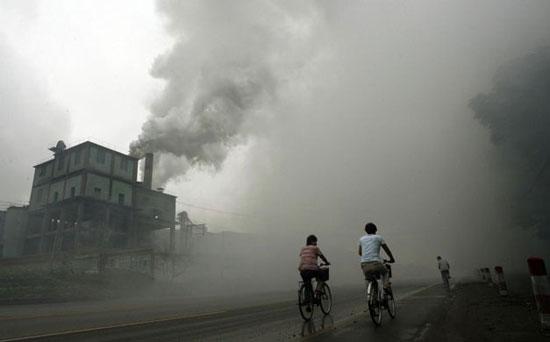

Yutian, Hebei province: Cyclists ride through a cloud of pollution produced by a nearby factory.
North China's Hebei Province has been struggling to contain dense smog that often engulfs the region. The province's heavy dependence on coal has made the work to tackle air pollution more difficult. Our reporter Ning Hong visited the province to see what measures are being taken.
This region has the worst air quality in all of China.
Containing air pollution is the local government's main task.
Yu Hua Thermal Power Plant, in the provincial capital Shijiazhuang is installing special equipment, to filter the emissions that are released. Its two-power unit used to discharge nearly ten thousand tons of the common pollutant oxynitride every year.
"The designed efficiency of our equipment is 80%, we could reduce oxynitride emission by eight thousand tons." Wang Xiaoyi, engineer of Yu Hua Thermal Power Plant, said.
However, the new equipment will cost 140 million yuan, but the plant's profits are only 50 million a year. The pressure put on the provincial government is leaving them with no choice.
"We plan to finish the installation by 2015. The estimated investment will be 330 million yuan." Wang said.
In the mean time, over 600 coal-fired boilers have been dismantled in Shijiazhuang.
"We need alternative energy sources to replace coal. That could be natural gas. But the natural gas supply mainly relies on imports." Yin Guangping, deputy director of Hebei Environmental Protection Office, said.
In order to monitor air pollution, the province's environmental protection office has turned to advanced satellite technology.
"We can find the basic patterns of air pollution using satellite remote censoring. That enables us to know how vast and severe it is." Zhang Feng, deputy chief of Hebei Environmental Protection Office, said.
The next step is to expand the monitoring area to counties in order to cover the entire region.
"The goal to reduce PM2.5 levels has put pressure on local governments. We're planning to publish the worst ten or twenty regions by next year." Chen Guoying, director of Hebei Environmental Protection Office, said.
Copyright ©1999-2018
Chinanews.com. All rights reserved.
Reproduction in whole or in part without permission is prohibited.